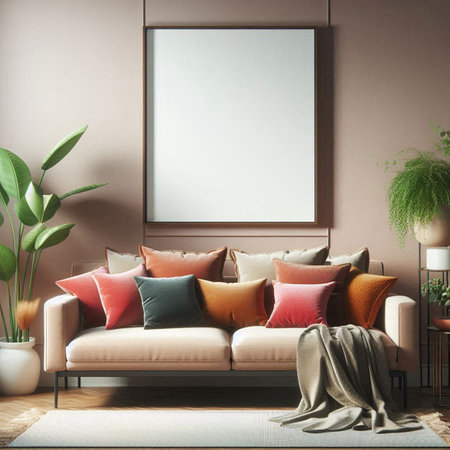1. Understanding the Gallery Wall Trend in the UK
Gallery walls have swiftly become a staple in British homes, blending both practicality and personality to transform blank spaces into striking visual narratives. Drawing inspiration from the stately elegance of Georgian townhouses to the eclectic charm of modern London flats, this trend speaks directly to the British love for both heritage and innovation. The gallery wall allows homeowners to curate personal art collections that reflect their journeys, interests, and memories—without breaking the bank. Unlike traditional single-statement art pieces, gallery walls are inherently flexible and can be tailored to any budget or room size, making them especially appealing for renters and first-time buyers across the UK. Whether you’re drawn to vintage prints picked up at local car boot sales or contemporary works from emerging British artists, a gallery wall offers an accessible way to celebrate your unique taste while adding warmth and character to your living space. This trend isn’t just about aesthetics; it’s about storytelling—turning your hallway, lounge, or stairwell into a dynamic showcase of who you are and what you cherish.
Choosing a Theme and Sourcing Affordable Art
Creating a gallery wall on a shoestring in the UK begins with selecting a unifying theme to give your collection coherence. Whether you lean towards British landscapes, quirky illustrations, or family memories, anchoring your choices around a central idea will make even the most eclectic pieces feel intentional. Once your theme is set, it’s time to source art without breaking the bank. Here are some practical tips tailored for UK-based collectors:
Curating Your Collection: Where to Find Art on a Budget
| Source | What Youll Find | Tips for Success |
|---|---|---|
| Local Artists & Makers | Original prints, paintings, textiles, ceramics |
|
| Charity Shops | Framed artwork, vintage prints, quirky posters |
|
| Car Boot Sales | Eclectic finds, retro prints, unique oddities |
|
| Online Marketplaces (e.g., Gumtree, eBay UK, Facebook Marketplace) | Affordable posters, limited edition prints, vintage maps |
|
Supporting Local Creativity While Staying Frugal
The beauty of curating a personal gallery wall in Britain lies in celebrating both your individual style and local talent. When possible, prioritise supporting emerging artists from your community—this not only enhances your collection’s uniqueness but also helps foster the local creative scene. Don’t shy away from mixing high-street bargains with original works; an interesting blend of sources makes your wall truly one-of-a-kind. Remember: patience pays off. Building a gallery wall is about gradual curation rather than instant perfection.

3. Selecting and Preparing Your Wall Space
Choosing the right wall for your gallery display is a crucial step, especially when working within the unique quirks of UK homes—think rental agreements, period features, and that ever-present concern about not upsetting your landlord. Begin by assessing spaces with good natural or artificial lighting, as these will allow your art to shine without being bleached by harsh sunlight or lost in the shadows. Hallways, living rooms, and staircases in British homes often make excellent candidates for gallery walls due to their visibility and centrality.
When renting, its vital to check your tenancy agreement before reaching for the drill. Many UK landlords are particular about tenants making alterations to walls. Where possible, opt for damage-free solutions such as adhesive hooks or picture hanging strips. These are widely available in DIY shops like B&Q or Wilko and can bear a surprising amount of weight without leaving marks—a win-win for renters.
If you’re lucky enough to live in an older property, you may encounter lath-and-plaster walls or uneven surfaces. In such cases, always test hanging methods on a less visible area first. For heavier pieces, consider using rail systems that distribute weight more evenly or consult with your letting agent for permission to install more secure fixings.
Before you start hanging anything, give your chosen wall a gentle clean with a damp cloth to remove dust—this helps adhesives stick better and prevents artwork from looking grimy over time. If you want to go one step further, a fresh lick of paint in a neutral shade like ‘Cotton White’ or ‘Dove Grey’ (popular choices in British interiors) can provide a crisp backdrop that makes your collection pop.
Ultimately, picking the right spot comes down to balancing practicality with aesthetics: opt for spaces where you’ll see and enjoy your art daily, but don’t forget to respect the rules of your home and its historic character.
4. Framing on a Budget
When it comes to gallery walls, the cost of framing can quickly add up, but there are plenty of savvy ways to keep your project wallet-friendly while maintaining British style and charm. From charity shop gems to DIY upcycling, here’s how to source and create affordable frames that suit your personal collection.
Second-Hand Frames: Treasure Hunting in the UK
One of the most cost-effective options is scouring local charity shops, car boot sales, and online marketplaces like Gumtree or Facebook Marketplace. These places often have a wide variety of frames—sometimes vintage, sometimes modern—that can be repurposed for your art wall at a fraction of the high street price.
| Where to Look | Typical Price Range | Tips |
|---|---|---|
| Charity Shops (e.g., Oxfam, British Heart Foundation) | £1–£5 per frame | Look for sturdy wood or metal frames; ignore the existing artwork inside. |
| Car Boot Sales | £0.50–£3 per frame | Bargain for bundles; inspect glass for cracks before buying. |
| Online Marketplaces (Gumtree, Facebook Marketplace) | Free–£10 for mixed lots | Search “job lot frames”; arrange collection locally to save on postage. |
Upcycling: Giving Old Frames New Life
If you find frames that are a bit tired or mismatched, don’t be put off. A lick of paint using tester pots from B&Q or Wilko, or even some decorative washi tape from Hobbycraft, can completely transform their appearance. Sand down rough edges and consider swapping out mount boards using affordable sheets from The Range or even recycled card.
Simple Upcycling Steps:
- Clean the frame thoroughly and lightly sand any rough patches.
- Apply a primer if you’re painting over varnished wood.
- Paint with your chosen colour; let each coat dry fully.
- Add new mounts or backing if needed; cut to size for a snug fit.
- Polish the glass and reassemble—ready for hanging!
British Retailers for Affordable New Frames
If second-hand isn’t your style or you need specific sizes, several UK retailers offer budget-friendly options:
| Retailer | Price Range (A4 size) | Noteworthy Features |
|---|---|---|
| IKEA UK | £2–£8 | Sleek designs, multiple colours, easy to hang. |
| The Range | £1.50–£10 | Wide variety including ornate styles and multi-packs. |
| Poundland & Wilko | From £1 | No-frills basics—great for simple gallery walls on a tight budget. |
| Dunelm & Argos | £3–£12 | Slightly higher quality materials and finishes for special pieces. |
Top Tip:
If you’re mixing new and old frames, unify them with a common element—a shared colour palette, finish, or mount style—to keep your gallery wall cohesive without overspending.
5. Laying Out Your Gallery Wall
Arranging your gallery wall is where creativity meets practicality, and it’s vital to plan carefully before you put anything up – especially if you want to avoid drilling unnecessary holes or causing damage to your walls. Here’s a step-by-step guide tailored for UK homes, ensuring you achieve that curated look without breaking the bank or your plasterwork.
Step 1: Gather Your Tools
Before starting, collect all your chosen artwork, a roll of brown paper or newspaper, a pencil, measuring tape, Blu Tack, and some masking tape. These household items will help you visualise the layout and reposition pieces easily until you’re satisfied with the arrangement.
Step 2: Trace and Cut Out Templates
Lay each frame or item flat on your paper and trace around it. Cut out these shapes to create life-size templates of every piece you want to hang. This makes it easy to play around with layouts without touching the wall yet.
Step 3: Plan Your Layout on the Floor
Start by arranging your cut-outs on the floor in front of your intended wall space. Experiment with different combinations — try mixing frame sizes and styles for an eclectic British look, or keep things symmetrical for something more classic. Consider spacing; around 5-8cm between pieces usually works well in most UK living rooms or hallways.
Step 4: Transfer to the Wall Using Blu Tack
Once you’re happy with the floor arrangement, stick each paper template onto the wall using Blu Tack. This gentle adhesive is perfect for painted or wallpapered surfaces common in UK homes, as it won’t leave marks or pull off paint when removed carefully. Stand back frequently to check proportions and balance from various angles — natural light can make things look very different throughout the day.
Step 5: Final Adjustments Before Hanging
If something feels off, don’t hesitate to move templates around until everything looks just right. Get a second opinion if possible — British interiors often benefit from a fresh pair of eyes! Once satisfied, mark the top centre of each template lightly with a pencil; this will guide nail or hook placement later.
Handy Tip:
If you’re renting or keen to avoid any holes altogether, consider using Command Strips or picture hanging strips available in most UK DIY shops like B&Q or Homebase. They hold frames securely and can be removed cleanly when it’s time for a change.
Your Gallery Wall Awaits
This careful planning ensures that when it comes time to actually hang your art, you’ll feel confident about every placement — no regrets and no unnecessary repairs required. With just some paper, Blu Tack, and patience, your personalised gallery wall will come together beautifully and damage-free.
6. Hanging Art: Tools and Techniques
Creating a stunning gallery wall in your UK home doesn’t have to be daunting, especially when you use the right approach for your property’s unique characteristics. From solid brick terraces to rented flats with delicate plaster, using suitable tools and methods ensures your collection is both secure and landlord-friendly.
Choosing the Right Hardware
For most British homes, youll encounter either brick or plaster walls. For brick walls, traditional masonry nails or wall plugs paired with sturdy screws offer reliable support. Always use a hammer drill to avoid damaging your walls and opt for picture hooks rated for your artworks weight. For plasterboard, consider specialist fixings like butterfly or toggle bolts, which spread the load and prevent cracking. Command strips or adhesive hooks are excellent alternatives in rentals where you need to avoid leaving marks.
Mindful Placement and Spacing
Lay out your arrangement on the floor first, using masking tape to map out where each piece will go on the wall. This allows you to experiment with spacing and height—aim for eye level (about 145cm from the floor) as a central guideline, adjusting slightly for furniture placement or ceiling height typical in UK properties.
Respecting Letting Agreements
If youre renting, always check your tenancy agreement before making any holes. Many landlords permit hanging lightweight art if you use removable fittings; however, it’s wise to get permission in writing. Keep a record of any existing marks and fill holes neatly at the end of your tenancy using ready-mixed filler—a must-have in every UK tenant’s DIY kit.
Safety and Longevity Tips
Never hang heavy pieces above beds or sofas unless youre certain of the walls integrity. Use a spirit level for straight lines and double-check fixings periodically—older UK homes can shift, so regular checks prevent surprises. Finally, keep all tools tidy and clean up after yourself; nothing ruins a newly curated gallery wall like dust left behind on your skirting boards!
7. Maintaining and Refreshing Your Collection
Keeping Your Gallery Wall Fresh
Once you’ve lovingly assembled your gallery wall, the real fun begins: keeping it looking sharp and reflecting your ever-changing style. Just like any feature in your home, a gallery wall benefits from regular attention. Dust frames with a soft cloth every fortnight, especially if you live in an older British property where dust can be quick to settle. For glass-fronted frames, use a gentle glass cleaner sprayed onto a cloth (never directly onto the frame) to avoid streaks or damage to the wall surface.
Safely Swapping Pieces as Your Taste Evolves
Tastes change – that’s half the joy of personal art collections. When you feel it’s time for a refresh, always remove pictures carefully by supporting both the frame and its fixings. If you’ve used Command strips or similar non-permanent fixings (a top tip for rented accommodation across the UK), follow the manufacturer’s instructions to avoid damaging your walls. Keep old fixings handy for future use or repairs.
Suggestions for Updating Your Display
- Rotate Seasonally: Swap out artworks to reflect the seasons – lighter, botanical prints in spring; bold abstracts in winter.
- Add New Finds: Charity shops, local art fairs, and even car boot sales are treasure troves for affordable pieces that add character and support local artists.
- Mix in Memories: Personal touches such as postcards from UK holidays, ticket stubs from West End shows, or children’s artwork keep your display meaningful and unique.
Repair and Upkeep Tips
- Check fixings at least twice a year to ensure nothing is loosening or pulling away from the wall – particularly important in older homes where plaster can be crumbly.
- If frames show signs of wear, touch up chips with matching paint or wood polish for wooden frames.
A Living Feature
Your gallery wall should grow with you. By taking these simple steps to maintain and update your collection, you’ll keep your home stylish, welcoming, and full of stories – all without breaking the bank.


